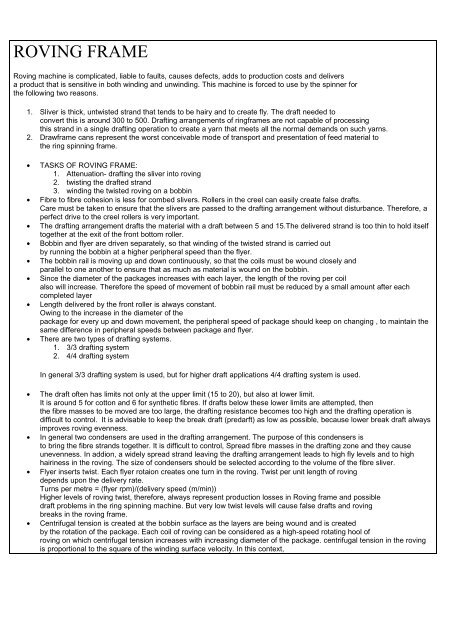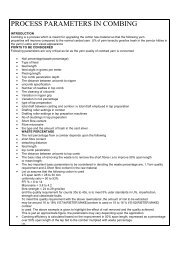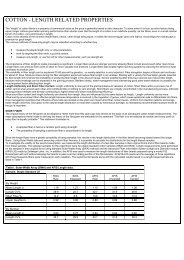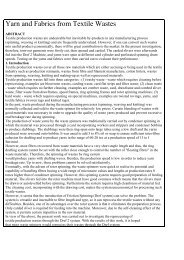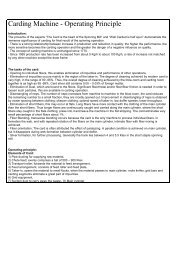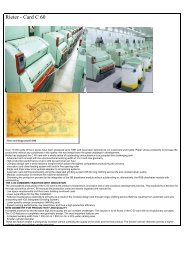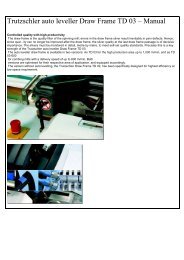Create successful ePaper yourself
Turn your PDF publications into a flip-book with our unique Google optimized e-Paper software.
<strong>ROVING</strong> <strong>FRAME</strong><br />
Roving machine is complicated, liable to faults, causes defects, adds to production costs and delivers<br />
a product that is sensitive in both winding and unwinding. This machine is forced to use by the spinner for<br />
the following two reasons.<br />
1. Sliver is thick, untwisted strand that tends to be hairy and to create fly. The draft needed to<br />
convert this is around 300 to 500. Drafting arrangements of ringframes are not capable of processing<br />
this strand in a single drafting operation to create a yarn that meets all the normal demands on such yarns.<br />
2. Drawframe cans represent the worst conceivable mode of transport and presentation of feed material to<br />
the ring spinning frame.<br />
• TASKS OF <strong>ROVING</strong> <strong>FRAME</strong>:<br />
1. Attenuation- drafting the sliver into roving<br />
2. twisting the drafted strand<br />
3. winding the twisted roving on a bobbin<br />
• Fibre to fibre cohesion is less for combed slivers. Rollers in the creel can easily create false drafts.<br />
Care must be taken to ensure that the slivers are passed to the drafting arrangement without disturbance. Therefore, a<br />
perfect drive to the creel rollers is very important.<br />
• The drafting arrangement drafts the material with a draft between 5 and 15.The delivered strand is too thin to hold itself<br />
together at the exit of the front bottom roller.<br />
• Bobbin and flyer are driven separately, so that winding of the twisted strand is carried out<br />
by running the bobbin at a higher peripheral speed than the flyer.<br />
• The bobbin rail is moving up and down continuously, so that the coils must be wound closely and<br />
parallel to one another to ensure that as much as material is wound on the bobbin.<br />
• Since the diameter of the packages increases with each layer, the length of the roving per coil<br />
also will increase. Therefore the speed of movement of bobbin rail must be reduced by a small amount after each<br />
completed layer<br />
• Length delivered by the front roller is always constant.<br />
Owing to the increase in the diameter of the<br />
package for every up and down movement, the peripheral speed of package should keep on changing , to maintain the<br />
same difference in peripheral speeds between package and flyer.<br />
• There are two types of drafting systems.<br />
1. 3/3 drafting system<br />
2. 4/4 drafting system<br />
In general 3/3 drafting system is used, but for higher draft applications 4/4 drafting system is used.<br />
• The draft often has limits not only at the upper limit (15 to 20), but also at lower limit.<br />
It is around 5 for cotton and 6 for synthetic fibres. If drafts below these lower limits are attempted, then<br />
the fibre masses to be moved are too large, the drafting resistance becomes too high and the drafting operation is<br />
difficult to control. It is advisable to keep the break draft (predarft) as low as possible, because lower break draft always<br />
improves roving evenness.<br />
• In general two condensers are used in the drafting arrangement. The purpose of this condensers is<br />
to bring the fibre strands together. It is difficult to control, Spread fibre masses in the drafting zone and they cause<br />
unevenness. In addion, a widely spread strand leaving the drafting arrangement leads to high fly levels and to high<br />
hairiness in the roving. The size of condensers should be selected according to the volume of the fibre sliver.<br />
• Flyer inserts twist. Each flyer rotaion creates one turn in the roving. Twist per unit length of roving<br />
depends upon the delivery rate.<br />
Turns per metre = (flyer rpm)/(delivery speed (m/min))<br />
Higher levels of roving twist, therefore, always represent production losses in Roving frame and possible<br />
draft problems in the ring spinning machine. But very low twist levels will cause false drafts and roving<br />
breaks in the roving frame.<br />
• Centrifugal tension is created at the bobbin surface as the layers are being wound and is created<br />
by the rotation of the package. Each coil of roving can be considered as a high-speed rotating hool of<br />
roving on which centrifugal tension increases with increasing diameter of the package. centrifugal tension in the roving<br />
is proportional to the square of the winding surface velocity. In this context,
ccentrifugal force acts in such a manner as to lift the top roving strand from the surface of the package<br />
so that the radial forces within the strand that hold the fibres together are reduced and the roving<br />
can be stressed to the point of rupture. Breaks of this type may occur at the winding-on Point of the presser or in<br />
strands that have just been wound on the top surface of the package. This phenomenon is known as "bobbin-bursting".<br />
This phenomenon will be prominent if the twist per inch is less or the spindle speed is extremely high when the bobbin is<br />
big.<br />
• Apart from inserting twist, the flyer has to lead the very sensitive strand from the flyer top to the<br />
package without introducing false drafts. Latest flyers have a very smooth guide tube set into one flyer leg and the other<br />
flyer leg serves to balance the flyer. The strand is completely protected against air flows and the roving is no longer<br />
pressed with considerable force against the metal of the leg, as it is in<br />
the previous designs. Frictional resistance is considerably reduced, so that the strand can be pulled through with much<br />
less force.<br />
• False twisters are used on the flyers to add false twist when the roving is being twisted between the<br />
front roller and the flyer.Because of this additional twist, the roving is strongly twisted and this reduces the breakage<br />
rate. Spinning triangle is also reduced which will reduce the fibre fly and lap formation on<br />
the front bottom roller. Because of the false twister, the roving becomes compact which helps to increase the length<br />
wound on the bobbin. This compactness helps to increase the flyer speed also.<br />
• Roving strength is a major factor in determining winding limitations. It must be high enough for the fibres<br />
to hold together in a cohesive strand and low enough for satisfactory drafting at the spinning machine.<br />
The factors affecting roving strength are as follows:<br />
o the length, fineness, and parallelisation of fibres<br />
o the amount of twist and compactness of the roving<br />
o the uniformity of twist and linear density.<br />
• BUILDER MOTION: This device has to perform the following tasks<br />
0. to shift the belt according to the bobbin diameter increase<br />
1. to reverse the bobbin rail direction at top and bottom<br />
2. to shorten the lift after each layer to form tapered ends<br />
• Shifting of the belt is under the control of the ratchet wheel. The ratchet wheel is permitted to rotate<br />
by a half tooth. The bobbin diameter increases more or less rapidly depending upon roving hank. The belt must be<br />
shifted through corresponding steps. The amount of shifting, which depends upon the thickness of the roving, is<br />
modified by replacement of the ratchet wheel or by other gears.If a ratchet wheel with fewer teeth is inserted, then the<br />
belt is shifted through larger steps, i.e. it moves more rapidly, and vice versa.<br />
• To form a package, the layer must be laid next to its neighbours. For that the lay-on point must continually be moved.<br />
The shift of the winding point is effected by moving the bobbin rail. This raising and lowering is done by rails.Since the<br />
package diamter is steadily increasing, the lift speed must be reduced by a small amount after each completed layer.<br />
During winding of a package, the ratchet is rotated at every change-over.Reversal of the bobbin layer occurs little earlier for<br />
every reversal.This gives a conitnuous reduction in the lift of the rail . Thus bobbins are built with taper.


